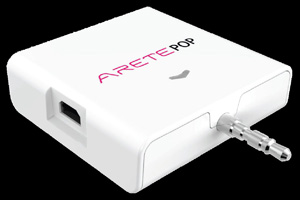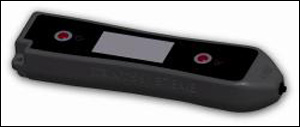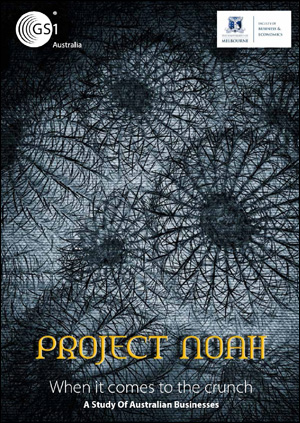The following are news announcements made during the past week by the following organizations: Checkpoint Systems; Phychips, Thinkify; Blue Spark Technologies, Trace Tech ID Solutions; KTS; Crescent Guardian, NControl; University of Melbourne and GS1 Australia; and Macy’s.
Major North American Retailer Adopts Checkpoint Systems’ RFID Solutions
Checkpoint Systems a provider of solutions for merchandise identification, tracking and security, has announced that a North American retail chain has finished deploying Checkpoint’s RFID solutions in all of its more than 1,000 stores. The retailer, which has declined to be identified, is using Checkpoint’s solution to improve inventory accuracy and merchandise availability, both in each individual store and across its retail channels, according to Checkpoint. The retailer conducted a pilot, and Checkpoint was able to complete the solution’s implementation chain-wide at more than 1,000 stores in just 100 days, Checkpoint reports. “The retailer selected us based upon many criteria, including our performance during a pilot on a significant number of stores over the past 18 months to two years, and our capability to scale up deployments of hundreds of stores per week,” said George Babich. Checkpoint’s CEO, president and director, during Checkpoint Systems Q3 2013 earnings conference call, held this morning. “Because the retailer views this RFID implementation as a competitive advantage, it’s chosen to remain anonymous at this time, and we respect those wishes.” The solution includes Checkpoint’s Merchandise Visibility enterprise software running centrally in the retailer’s data center, as well as handheld RFID readers to perform regular in-store inventory counts, and Checkpoint’s ultrahigh-frequency (UHF) EPC Gen 2 RFID tags and labels for initial store tagging, tagging at distribution centers, and source tagging. The RFID solution is designed to provide the retailer with improved operational visibility, so that products move from stock rooms to the sales floor at the proper time, and also to optimize the location of inventory throughout the supply chain and stores.
Phychips Selects Thinkify as Its Exclusive North American Distributor
Korean RFID technology firm Phychips has selected Thinkify, a U.S. provider of RFID hardware, software and services, as its exclusive North American distributor. Phychips’ line of ultrahigh-frequency (UHF) RFID products include RFID reader chipsets, embeddable modules, small high-performance antennas and complete RFID readers for tags conforming to the EPC Gen 2 standard and ISO 18000-6C standards (see South Korean Consortium Launches EPC Gen 2 Reader for Mobile Phones). Among Phychips’ products that Thinkify will distribute is the Arete Pop Smart RFID dongle reader. The dongle reader is compatible with most Apple iOS and Google Android devices (above iOS 6.0 and Android 2.3.3), and plugs into the devices’ headphone jack, turning the device into an RFID reader. It has an average read range of approximately 0.5 meter (1.6 feet) and includes read, write, lock and kill functions, a software development kit (SDK) and an application programming interface (API).
Blue Spark, Trace Tech to Develop Disposable RFID Temperature Sensors
Blue Spark Technologies, a manufacturer of thin printed batteries, and Trace Tech ID Solutions, a provider of RFID technology and solutions headquartered in Spain, have partnered to develop new battery-assisted passive (BAP) temperature-sensing RFID tags. BAP tags, also known as semi-passive tags, are designed to provide greater read range and reliability than purely passive tags. The new sensor solution, known as the DBT Cold Chain, leverages RFID inlays compliant with the ISO 18000-6C and 18000-6D standards, and has 4096 bits of non-volatile memory (EEPROM), a 48-bit manufacturer-programmed IC serial number, and 352 bits for UII/EPC encoding, according to Matt Ream, Blue Spark’s VP of marketing. Trace Tech currently offers two BAP products in the form of reusable cards, but the new solution is designed to be disposable, and as a one-time-use peel-and-stick smart label for a variety of cold chain applications, Ream says. Trace Tech will combine Blue Spark’s printed batteries with its automated smart label production capabilities, in order to produce disposable time-temperature monitoring smart labels, the two companies report. The BAP RFID temperature-sensing tags can be used on cases, pallets, containers and individual packages of perishable foods, such as meat, fish, and frozen and dairy products. They can also be used with temperature-sensitive chemicals, as well as with pharmaceuticals, such as vaccines and biologicals. Trace Tech’s DBT Cold Chain solution features immediate temperature monitoring, in addition to the ability to monitor temperature over time using its internal real-time clock. Using the monitoring function, the label can continuously monitor temperatures throughout the entire supply chain logistics cycle. With this feature, users have the ability to set alarms for high and low temperatures for defined periods of time. Samples of the DBT Cold Chain are available now, with commercial deliveries slated to be available in January 2014.
KTS Announces Bluetooth RFID Reader
KTS, a German engineering firm focused on RFID and Near Field Communication (NFC) applications, has introduced a new Bluetooth high-frequency (HF) RFID reader designed for use in industrial, health-care and other environments containing dust, dirt and water or other liquids, such as disinfectants. The BTR1356 Bluetooth RFID Reader is available in various designs and can be customized to meet a customer’s specific needs, the company reports. The reader is compliant with the ISO 15693 and ISO 14443A/B standards, comes with an IP 67 rating (indicating it to be dustproof and waterproof) and can withstand submersion in water for brief periods of time. The device has a built-in ferrite bar antenna, which KTS says allows for the accurate scanning and reading of small transponders. Options for built-in memory range from 2 gigabytes (capable of storing more than 1 million scans) to 32 gigabytes. Wireless data transmission, via Bluetooth, provides automatic updating of the read data sets. The reader comes with a power-saving electronic paper display, as well as KTS’ tag2IMAGE software, designed to support RFID application development.
Crescent Guardian and NControl Collaborate on RFID-enabled Security Solutions
Crescent Guardian, a security firm providing physical security and technology solutions, and NControl Security Integrations, a provider of RFID asset-tracking services, have announced a partnership to develop custom solutions designed to protect buildings, assets and individuals. Crescent Guardian provides end-to-end security that integrates multiple technologies and services, such as access control, video surveillance and RFID asset tracking, into a single solution for companies. “Customers have told us they want one person, one company, to be responsible for all their security systems they use,” says Ray Cavanagh, Crescent Guardian’s VP. “So if an alarm goes off in the middle of the night, there’s only one company to call. You don’t have to call the alarm company, and then the surveillance camera services provider, and others. Customers can just call us.” According to Cavanaugh, Crescent Guardian—which already features RFID products in its portfolio—opted to partner with NControl because NControl offers a wide variety of active and passive RFID products from multiple vendors, and also specializes in asset tracking. That variety is essential to providing custom security solutions to meet each client’s specific needs, Cavanaugh explains. The two companies will work together to integrate NControl’s various asset-tracking systems, including NEAT Lite, NEAT and NEAT Enterprise, into Crescent Guardian’s portfolio of security solutions. NEAT Lite is an entry-level asset-tracking system that supports up to five IP-based RFID readers. It is available in various packages, including one version that comes with a single reader, 10 asset tags and the software, as well as another version that only includes the software for customers that already have IP-based RFID hardware. NControl also offers the NEAT System, which lets users define various rules to perform “on-demand” actions when required. According to Crescent Guardian and NControl, this scalable system can track different types of assets, determine asset directionality, control doors, generate workstation alarms and activate video cameras, and offers two-man rule of increased security. The NEAT System is also available in various packages. NEAT Enterprise is designed for large-scale installations for which multiple locations are monitored, and gathers asset information from multiple locations, displaying the information on a single user interface. It can support up to 50 locations with an unlimited total of readers and assets. Like the other solutions, the system is available in various package options.
University of Melbourne Researchers Study Effect of GS1 Standards on Supply Chain Integration, Efficiency
New findings from a study in Australia show that the adoption of a number of technologies based on GS1 standards can lead to more integrated and efficient supply chains. The research study, named Project Noah, was conducted by the Department of Management and Marketing at the University of Melbourne‘s Faculty of Business and Economics, in cooperation with GS1 Australia. Two reports, titled “Project Noah: To Integrate or Not to Integrate? A Ten-Year Study of Australian Businesses” and the “Project Noah: When it Comes to the Crunch—A Study of Australian Businesses,” are the result of the joint research study, which is based on surveys of GS1 Australia’s membership. The objective of the research was to gain a deeper understanding of the issues affecting the adoption and use of supply chain technology standards in Australia. According to the researchers, the studies reveal how supply chain integration is a critical strategy for businesses today. In “When it Comes to the Crunch—A Study of Australian Businesses,” researchers found that the bar code is the number-one GS1 standards-based technology used by Australian businesses, and that the other three technologies—e-messaging, GDSN and EPC RFID—were recorded at similar levels of moderate to low usage. Adoption of EPC RFID technology was found to be low across all sectors, though usage was slightly higher for agricultural and food and beverage applications. Interestingly, the study found that businesses that have been members of GS1 Australia for more than 10 years were using e-messaging and EPC RFID at much lower levels than newer members. The study states that researches “expected businesses who are GS1 members to learn about and increase their usage of GS1 standards based technologies over time, especially as they would receive frequent communications promoting the technologies. However, this appears not to be the case.” The study attributes this to the fact that businesses tend to approach GS1 when they have already decided to implement the technologies, but notes that “there is a real opportunity for GS1 and existing members to work together to ensure businesses understand the advantages of GS1 standards based technologies above and beyond what they are mandated to do.” The research project collected data only from Australian firms, according to Dr. Richard Lars Gruner, a research fellow at the University of Melbourne. “I suspect that many of our findings also apply to countries where they use similar—or even the same—GS1-based technology standards,” he states. “But I can, of course, not make this statement with any certainty without having collected and analyzed data from these countries.”
Macy’s Launches Visual Recognition App to Simplify Consumer Purchases
While many retailers and product manufacturers are trying out QR codes and Near Field Communication (NFC) RFID tags to provide customers with additional information about a product, Macy’s is taking a different tack. The company is launching a new mobile application that leverages visual recognition technology so shoppers can purchase items whenever and wherever they are. The new Macy’s Star Gifts app has NantMobile‘s iD visual recognition technology integrated into it, so customers can purchase items from Macy’s Star Gifts catalog by simply pointing the device at a particular Star Gift item, featured on a page within the catalog, and then tapping the device’s screen to view additional information about that product. Star Gift items will also be featured in magazine advertisements, on outdoor digital billboards and in public spaces, such as subway stations, bus shelters and windowscapes, as well as in other catalogs available throughout the holiday shopping season. When NantMobile’s technology recognizes an item, the Macy’s app serves up product information, gift-giving assistance, videos and more. The Macy’s Star Gifts app is available for free at iTunes and Google Play. For a limited time, through Nov. 17, 2013, shoppers can also scan the first page of the Star Gifts catalog to receive a $10 Macy’s mobile Gift Code, enabling them to kick-start their holiday gift shopping. NantMobile says its technology platform can recognize 2D images, 3D objects, television content, music, speech, and QR and bar codes from any mobile computing device, capturing both the time and location of activation in real time.




